The hertitability of intelligence has traditionally been estimated using family members, usually twins. Due to skepticism of these methods, some have thought of estimating the heritability of traits by measuring the similarity of identical twins reared apart. Early on, there were a few samples of twins reared apart, but they were all small or collected by Burt, who was unfortunately falsely accused of fraud.
Slowly, more and more samples have been coming out, one being the Swedish Adoption/Twin Study on Aging (SATSA). I wasn’t satisfied with the methodology that was used to calculate the IQ scores in that study, so I did it myself1. Just a few years ago, IQ correlations within Danish and Chinese twins were released.
That leaves eight samples, two of which have been retested:
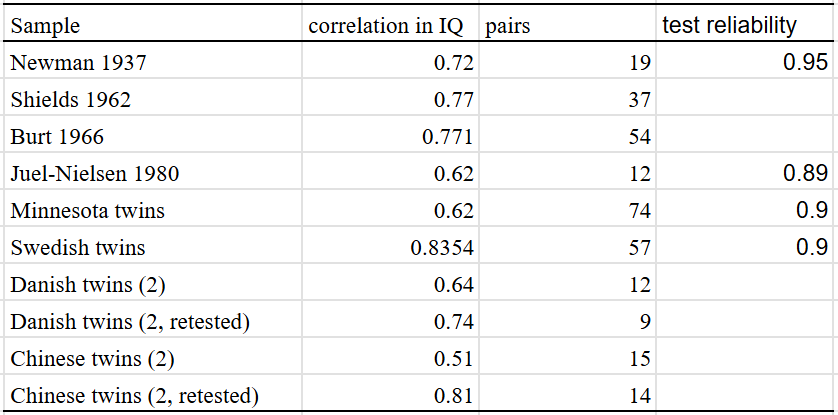
Subtracting the retests leaves us with a total of 280 pairs. I added a “retesting weight” which accounts for the fact that the samples of Danish and Chinese twins were tested twice. I assumed the studies without known test reliabilities had a reliability of 0.91, adjusted the correlations accordingly, and conducted the meta-analysis:
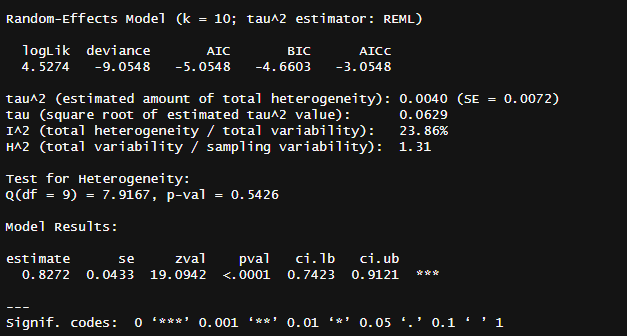
A mean correlation of 0.83 with a 95% confidence interval of 0.74 to 0.91. This implies the heritability of IQ is 74-91%; perhaps a few percent lower due to incomplete separation and prenatal environmental effects, but it concords with the estimates made using twin studies.
No evidence of publication bias was found, which is to be expected, as everybody who has a sample of identical twins reared apart will release the results regardless of what they are.
Links to all of the twin studies I mentioned:
One can download the spreadsheet I used here (it’s called rmz)
Took the first principal component of all intelligence tests administered within waves 1-7 (without filling missing values), adjusted the scores for year of birth and sex, calculated the first principal component of those seven scores (filling in missing values), and finally adjusted the scores for the fact that people who took the test more often had more variable scores. This left me with an equally valid cognitive score (correlation with education is 0.43 for the overall principal component, and 0.43 for the first principal component of just the first wave of tests), that left me with more samples. These were the correlations I got:
Bouchard has a correlation of .78 between 46 MZA pairs in the SATSA, which is pretty close.
Because I have nowhere else to put them, these are the correlations between twins in other traits. All were adjusted for sex/cohort effects.
correlation between both metrics is 0.73 - 0.80 .
These are the differences in IQ that I found in the SATSA:
PAIRID pc_twin1 pc_twin2 zygosity reared diff
<dbl> <dbl> <dbl> <chr> <chr> <dbl>
1 2488 0.5342 0.7623 MZ Apart 0.2281
2 11221 -1.544 -0.2200 MZ Apart 1.324
3 11309 -1.889 -1.792 MZ Apart 0.09632
4 11487 -0.2527 -0.4708 MZ Apart 0.2182
5 12462 -1.597 -1.310 MZ Apart 0.2865
6 12710 -1.442 -0.5692 MZ Apart 0.8727
7 13289 -0.3342 0.4027 MZ Apart 0.7370
8 13316 -0.7555 -0.9258 MZ Apart 0.1703
9 13579 0.8655 0.6991 MZ Apart 0.1663
10 13655 1.624 1.552 MZ Apart 0.07286
11 14834 0.1424 -0.2906 MZ Apart 0.4330
12 14904 -0.6089 -1.574 MZ Apart 0.9653
13 15030 0.8492 1.056 MZ Apart 0.2064
14 15160 -0.5888 -0.08980 MZ Apart 0.4990
15 15344 -0.6546 -0.4051 MZ Apart 0.2495
16 15348 -0.1268 -0.9689 MZ Apart 0.8421
17 15371 -0.1628 -0.1561 MZ Apart 0.006702
18 15575 0.06405 -0.5726 MZ Apart 0.6367
19 15602 -0.1246 -0.6769 MZ Apart 0.5523
20 16821 -0.3831 -0.04979 MZ Apart 0.3333
21 16876 -0.4608 -0.7466 MZ Apart 0.2858
22 17429 1.199 1.879 MZ Apart 0.6792
23 17660 -1.211 -1.464 MZ Apart 0.2525
24 17842 -0.1178 -0.0004025 MZ Apart 0.1174
25 18271 -0.03296 -0.5351 MZ Apart 0.5022
26 18413 0.3999 1.774 MZ Apart 1.374
27 18429 -0.6898 -1.072 MZ Apart 0.3826
28 18804 -0.7593 -0.9228 MZ Apart 0.1635
29 18885 0.3221 0.7334 MZ Apart 0.4113
30 21119 -1.694 -1.555 MZ Apart 0.1386
31 21362 -0.3941 -0.1520 MZ Apart 0.2421
32 22248 -0.3376 -0.4386 MZ Apart 0.1010
33 24159 -0.4002 0.1688 MZ Apart 0.5690
34 27019 1.090 1.226 MZ Apart 0.1360
35 27548 -0.05580 0.2797 MZ Apart 0.3355
36 29416 0.6582 -0.2550 MZ Apart 0.9131
37 211603 -1.118 -1.198 MZ Apart 0.08040
38 212112 -0.7201 -0.04612 MZ Apart 0.6740
39 212341 0.1817 -0.9569 MZ Apart 1.139
40 214307 -1.159 -1.491 MZ Apart 0.3314
41 214731 -0.6808 -1.351 MZ Apart 0.6703
42 217458 0.6069 1.091 MZ Apart 0.4845
43 217630 -1.969 -1.733 MZ Apart 0.2356
44 218811 -1.079 -1.538 MZ Apart 0.4599
45 221276 3.071 3.062 MZ Apart 0.008504
46 225868 0.8883 -0.1143 MZ Apart 1.003
47 13814 -0.6992 0.06772 MZ Apart 0.7670
48 16242 -0.01563 -0.3407 MZ Apart 0.3251
49 23099 -0.4021 -0.5105 MZ Apart 0.1083
50 24723 -0.4559 -1.162 MZ Apart 0.7059
51 215237 0.3275 0.5572 MZ Apart 0.2297
52 219557 -0.8348 -1.715 MZ Apart 0.8807
53 222229 -0.09049 -0.3794 MZ Apart 0.2889
54 224798 -0.007217 1.037 MZ Apart 1.044
55 225414 -1.825 -2.124 MZ Apart 0.2985
56 228259 0.8459 -0.3690 MZ Apart 1.215
57 232160 1.196 1.380 MZ Apart 0.1840
>


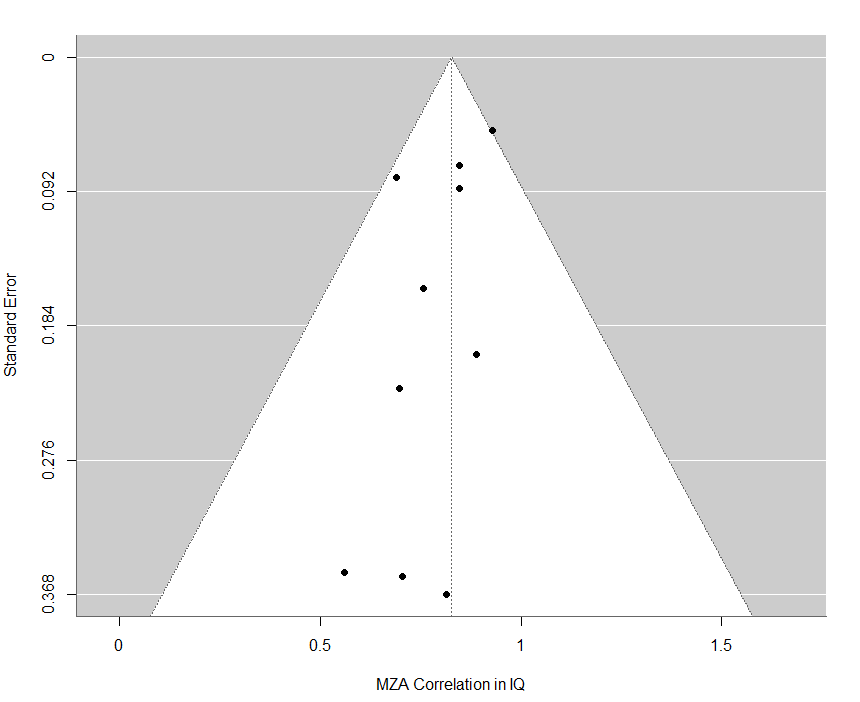

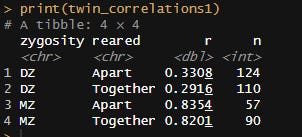
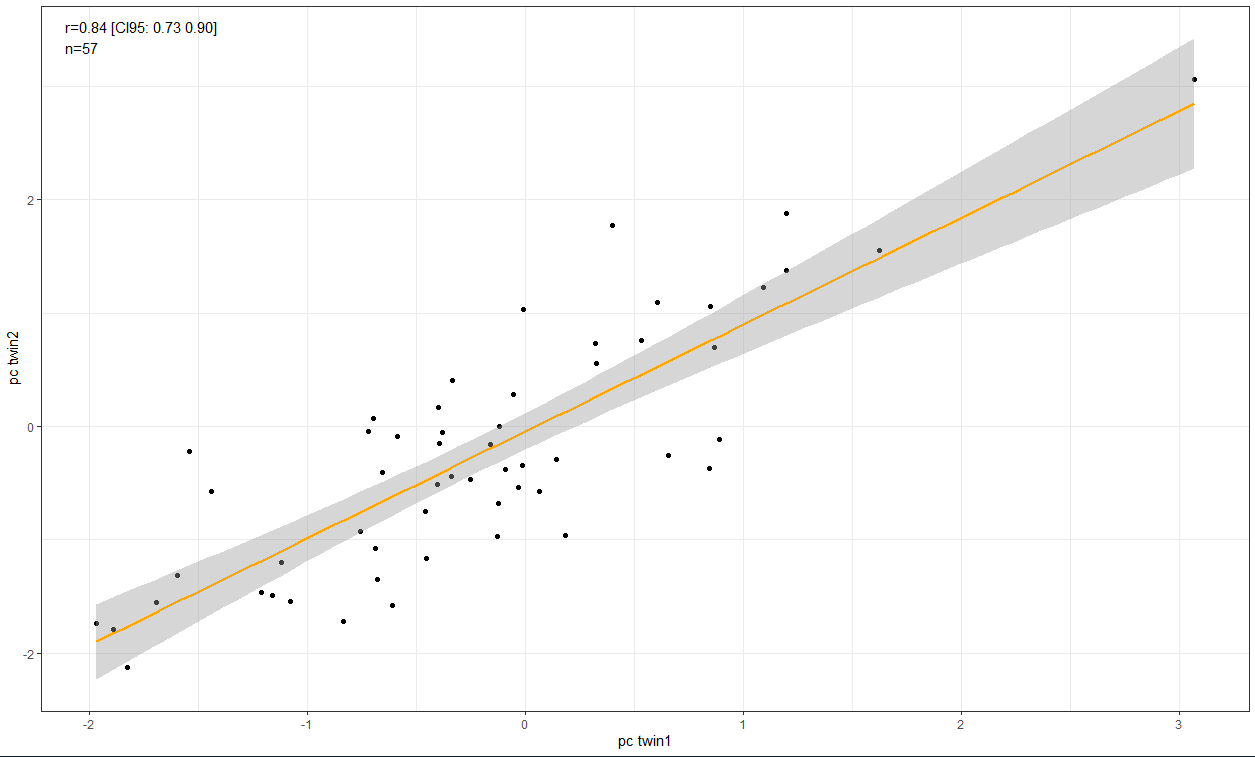
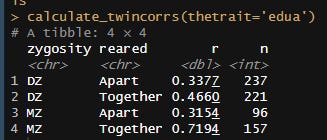
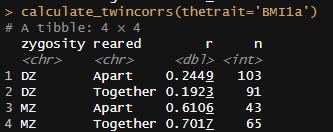
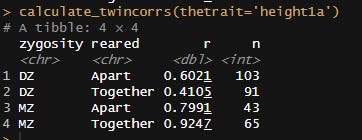
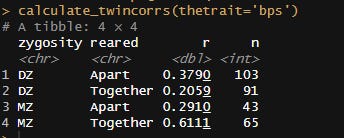
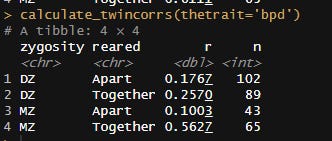
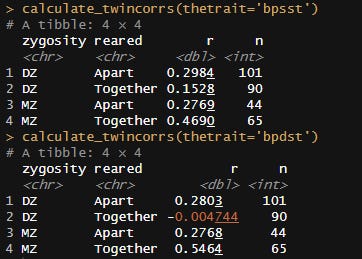
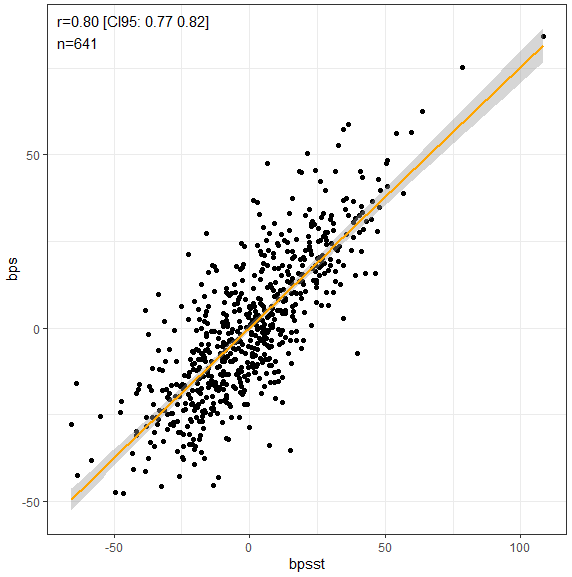
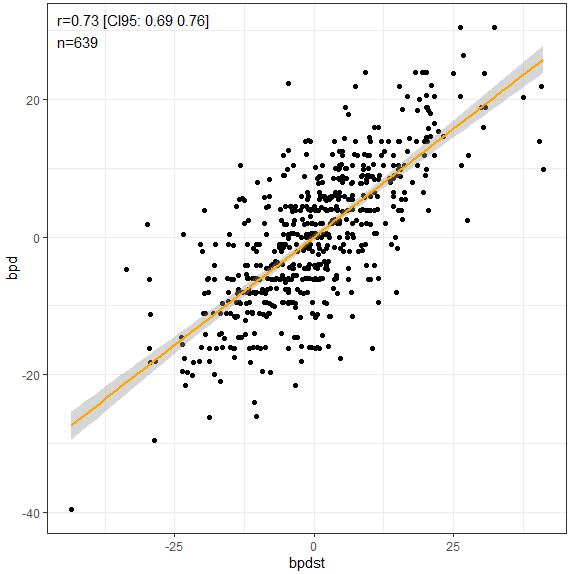
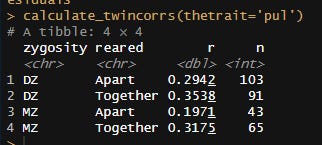
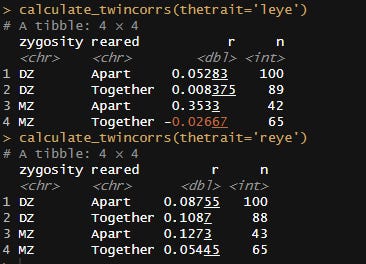
My vague hunch would be that identical twins reared apart tend to often both be raised about the 25th percentile of income. Say, identical twins are orphaned because the parents are killed in a car wreck or the parents both become drug addicts or whatever. So the extended family, maybe both sets of in-laws, gets together and says, "OK, I know this will be a major sacrifice, but we've got to dig deep and figure out who can afford to raise the two kids."
But nobody has the money to take both, so one couple takes one twin and another couple takes the other.
What’s the correlation for the mother to child and father to child? Is one larger than the other?